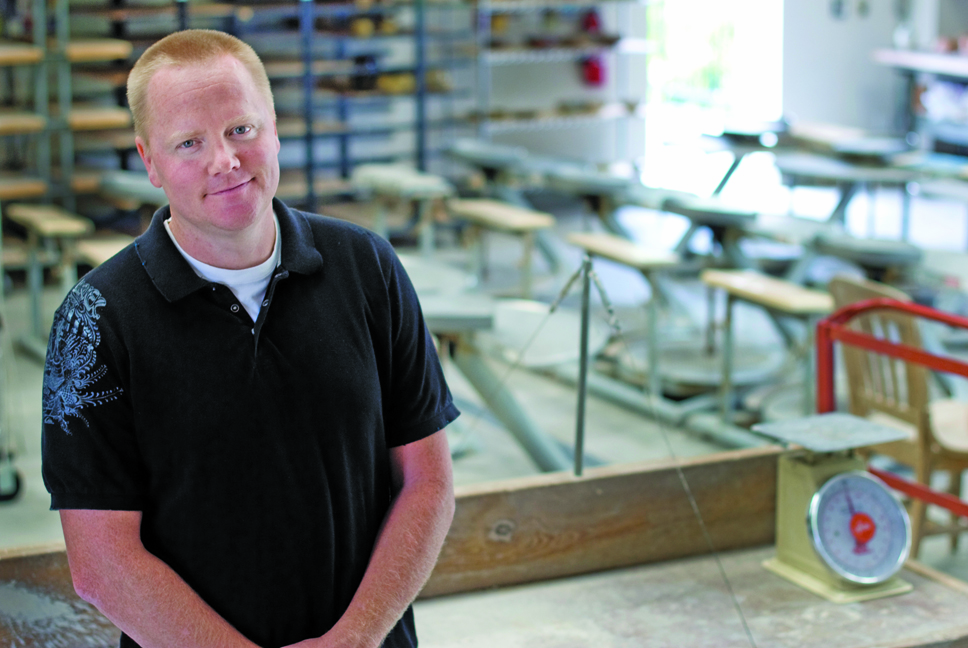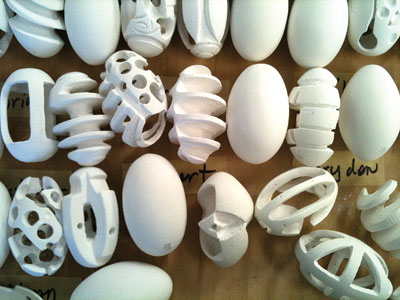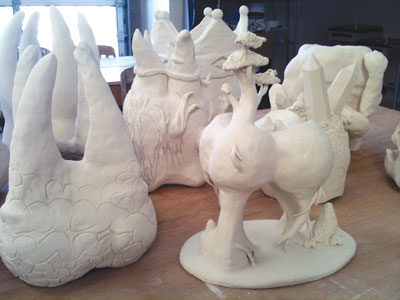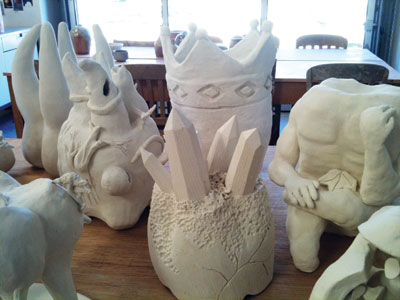By Sharon Mahoud
The introductory ceramics and sculpture classes taught by Visual Arts Professor Trent Burkett are popular general education courses on the Stockton campus. One reason they fill up so fast is they are highly coveted by predental students, who typically make up half of the students in the class. That’s because the Department of Biology encourages predental students to take these courses as a means of building dexterity and skill with hand tools as well as promoting other valuable characteristics such as individual expression and visual literacy.
Fateful Trip to the Dentist
Last year while Burkett was having his biannual cleaning with his dentist, Dr. Lester Low ’86, an alumnus of both Pacific and the Dugoni School of Dentistry, he learned about the Perceptual Ability Test (PAT) that prospective students take as part of a larger Dental Admission Test (DAT) prior to applying to dentistry schools. The PAT assesses a student’s ability to determine angles and shapes through logic and visual perception. For example, a student must determine how a complex geometric object can fit through an aperture.
Impressed by the difficulty of the test, Burkett said a light bulb went on. “I realized I could pattern a course from my existing sculpture and ceramics classes that offered a more in-depth focus on teaching students these skill sets,” he said.
After a relatively rapid approval process that involved meeting with the Department of Biology Co-Chair Gregg Jongeward and members of the Dugoni School of Dentistry in San Francisco, Burkett was able to offer his new course this past spring: predental ceramics.
Dr. Nader Nadershahi ’94, executive associate dean and associate dean for academic affairs at the dental school, who has done sculpture himself, was very interested in the idea. “The dental school wants its students to be well-rounded,” he said. “Being able to appreciate aesthetics, develop individual expression and articulate well verbally and in writing—all critical qualities a future dentist should possess—are promoted in Professor Burkett’s ceramics classes.”
Predental Ceramics Class Challenges and Inspires
A recent offering of the new predental ceramics class quickly filled during registration with 15 senior predental students, and students have been clamoring for more sessions to be offered. For the 3-unit course, Burkett took elements from his general ceramics classes but tailored the projects for predental students, upping the difficulty level and mostly focusing on small-scale works requiring a high degree of precision.
“I felt that the polishing techniques I learned in the predental ceramics class have followed through to the things I’m learning and doing in the simulation lab at dental school,” said Casey Luu, Class of 2014 and a student in the accelerated 3+3 program (where students spend three years of education on the Stockton campus followed by three years in dental school). “Working on small-scale projects was very helpful, especially working with the curvatures of various objects.”
One assignment required students to carve a perfect one-inch cube in plaster. However, creativity was also encouraged, and the final project called for students to create a “tooth-based” sculptural project—a creative, larger interpretation of teeth built in porcelain and fired in a kiln. These final works were judged and given awards, just like a juried art exhibit. The pieces were also displayed in the Biology Building on the Stockton campus.
[pullquote]“During the undergraduate program, we’re so concentrated on science and that’s not all dentistry is about.”[/pullquote]
“Our initial projects, particularly the microsculpture cube, were challenging but worthwhile,” said Brydan Regehr, Class of 2014. “During the course, we had a selection of dental tools to work with, in addition to sculpture tools. The class helped improve my hand-eye skills which have benefitted me as a first-year dental student.”
“The creativity level of the students is impressive, and some show a very strong artistic sense,” said Burkett. “Since predental students have to take so many science classes, it’s exciting to give them a creative outlet and see the outcome.”
The consensus among students was that the course was challenging but rewarding. One of the rewards was a PowerPoint presentation Burkett created for each student showing his or her predental ceramics projects. “The assignments were difficult and demanding,” noted Regehr. “Dr. Burkett pushed us to do our best and helped us gain an appreciation for the art of dentistry.”
Art and Science Connect
Burkett recently revisited the dental school and showed pictures of the projects the students had completed. The faculty, staff, and alumni were impressed. Kathy Candito, associate dean for student services, was very enthusiastic and suggested that Burkett show the student PowerPoint presentations at an upcoming event.
“I am glad that the idea worked and that I can make art relevant to other professional programs,” said Burkett. “This course proves that art can be useful for science and other disciplines.” The interdisciplinary nature of the experience has been rewarding. When Burkett walks over to the Biology Building, all of the predental students know him. “There’s a lot of interdepartmental and interschool collaboration happening at Pacific that people may not be aware of,” he said.
The Future of Predental Ceramics
Burkett hopes to get the predental ceramics class approved as a permanent general education course. His long-term idea is to offer a 3-D certificate to predental students composed of three courses: ceramics (wheel throwing), predental ceramics and his intermediate 3-D studio course.
“During the undergraduate program, we’re so concentrated on science and that’s not all dentistry is about,” said Luu. “The ceramics class opened my perspective and reminded me that dentistry is a combination of science and art.”
Sharon Mahood is an East Bay freelance writer who also writes for the College of the Pacific.

In Trent Burkett’s class, predental students improve their manual dexterity while getting to indulge their creative side. 

